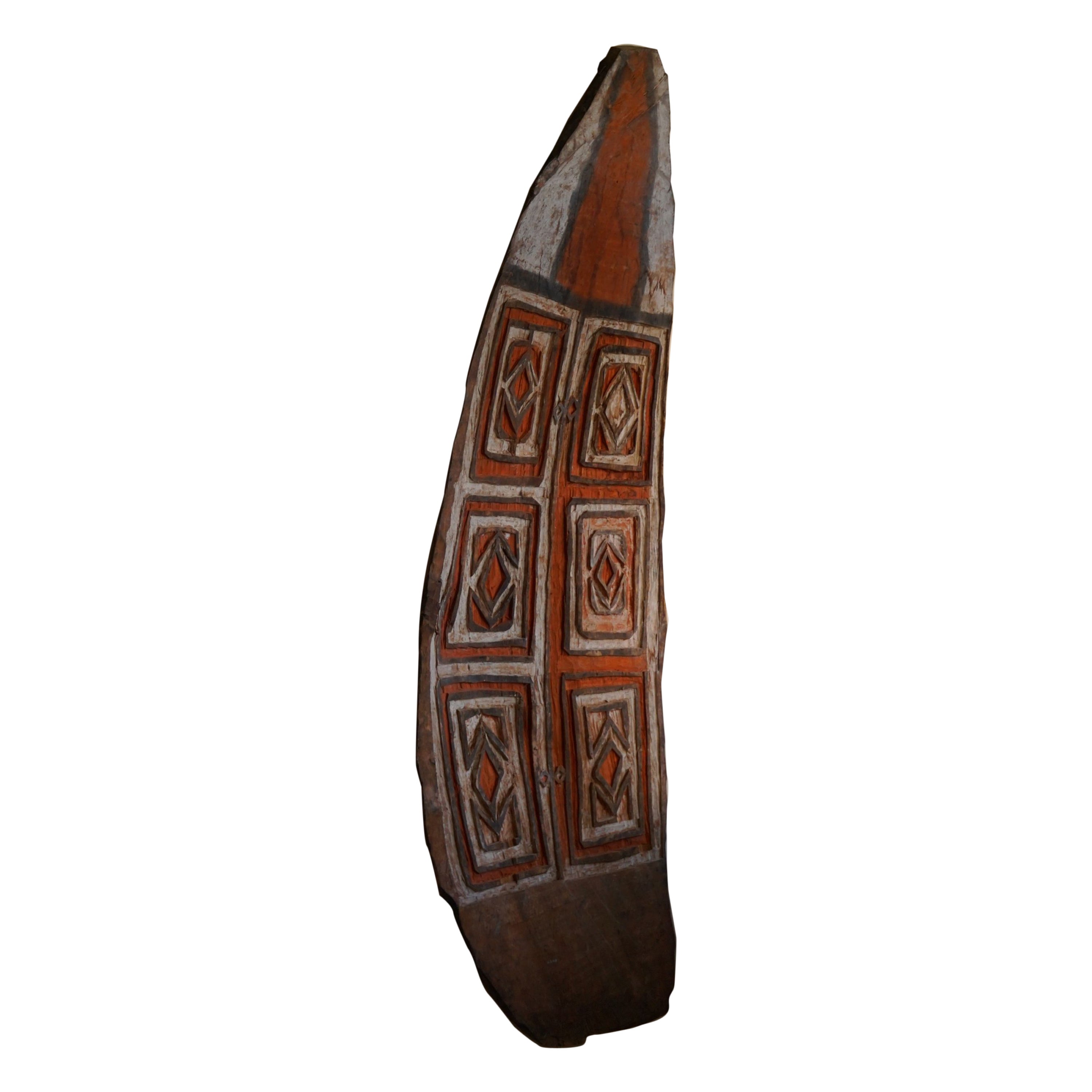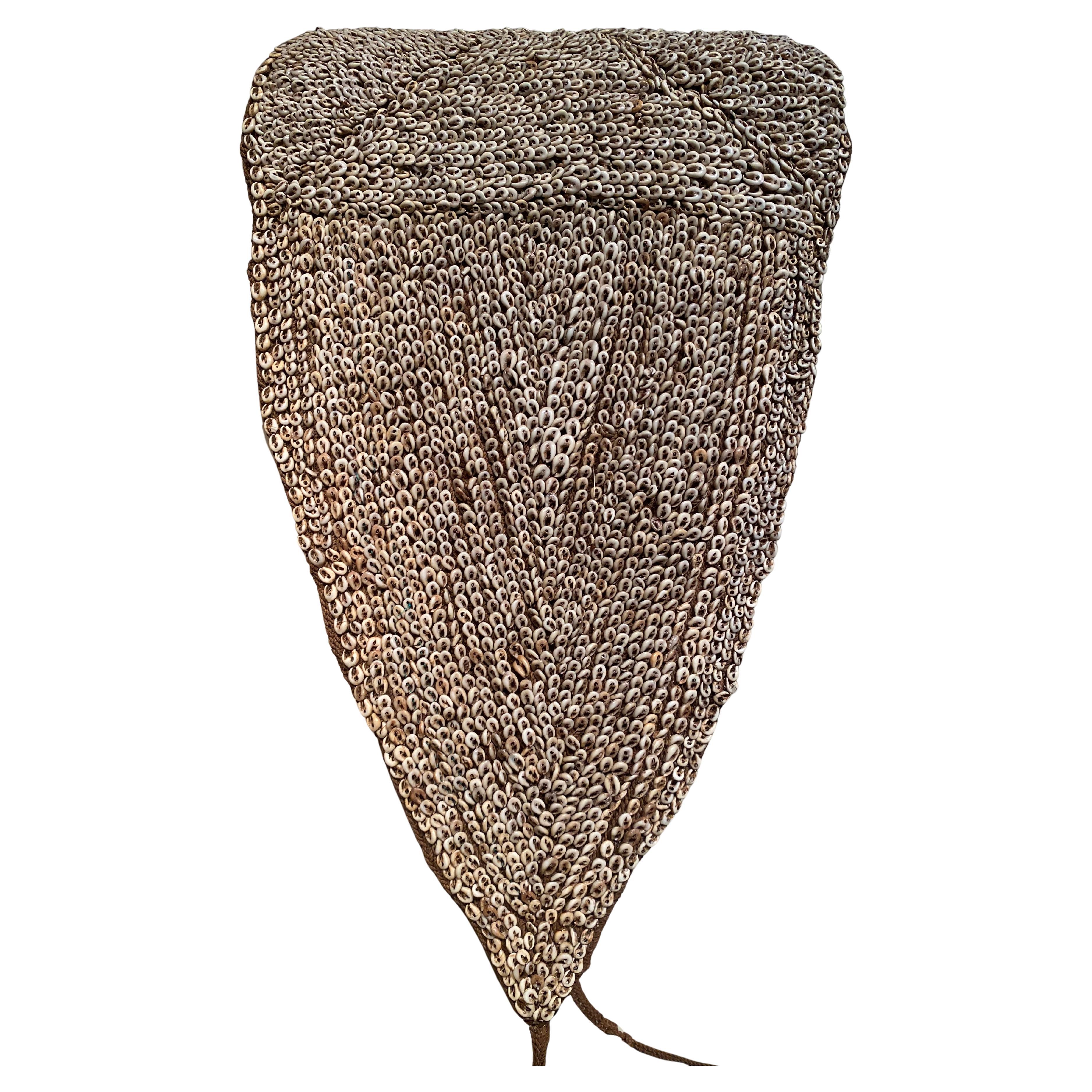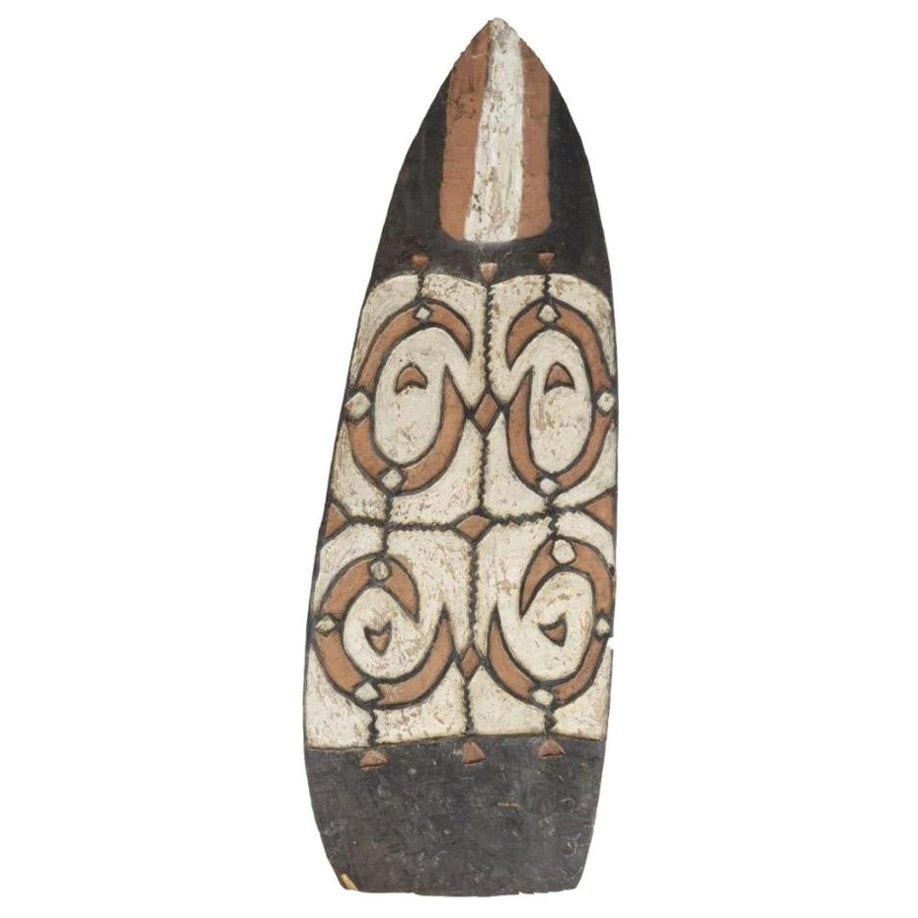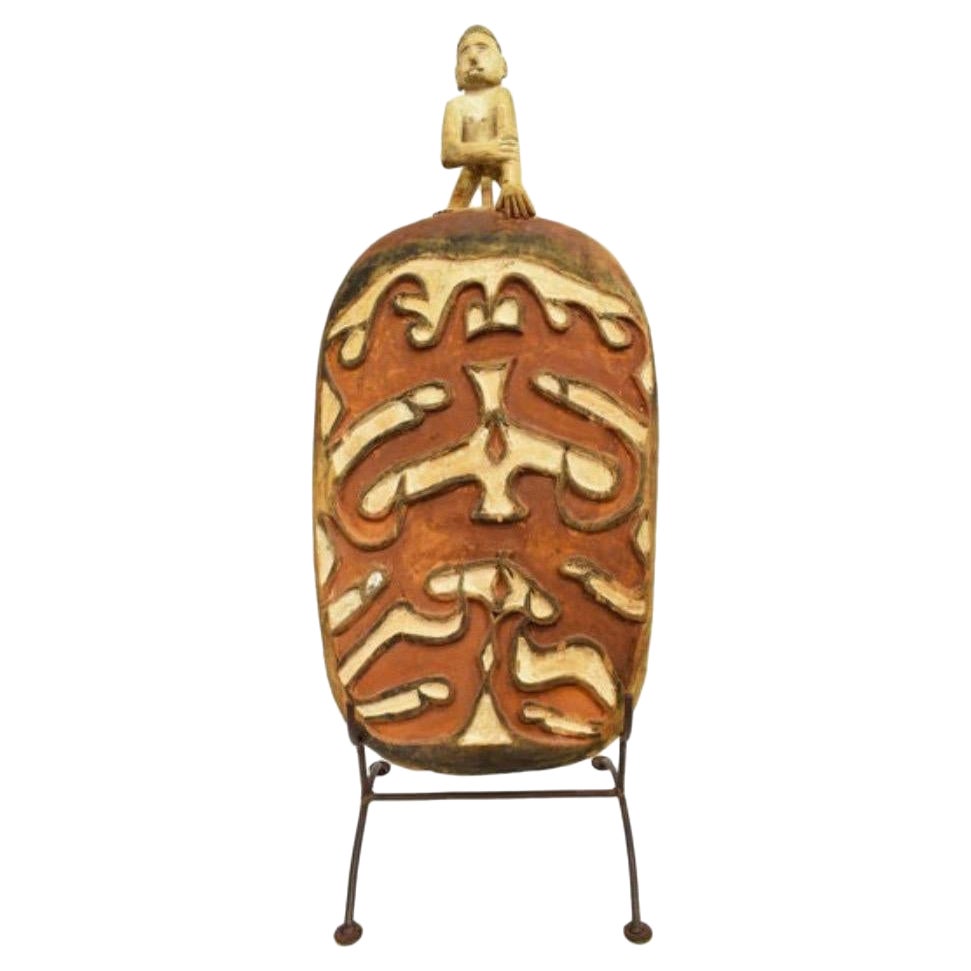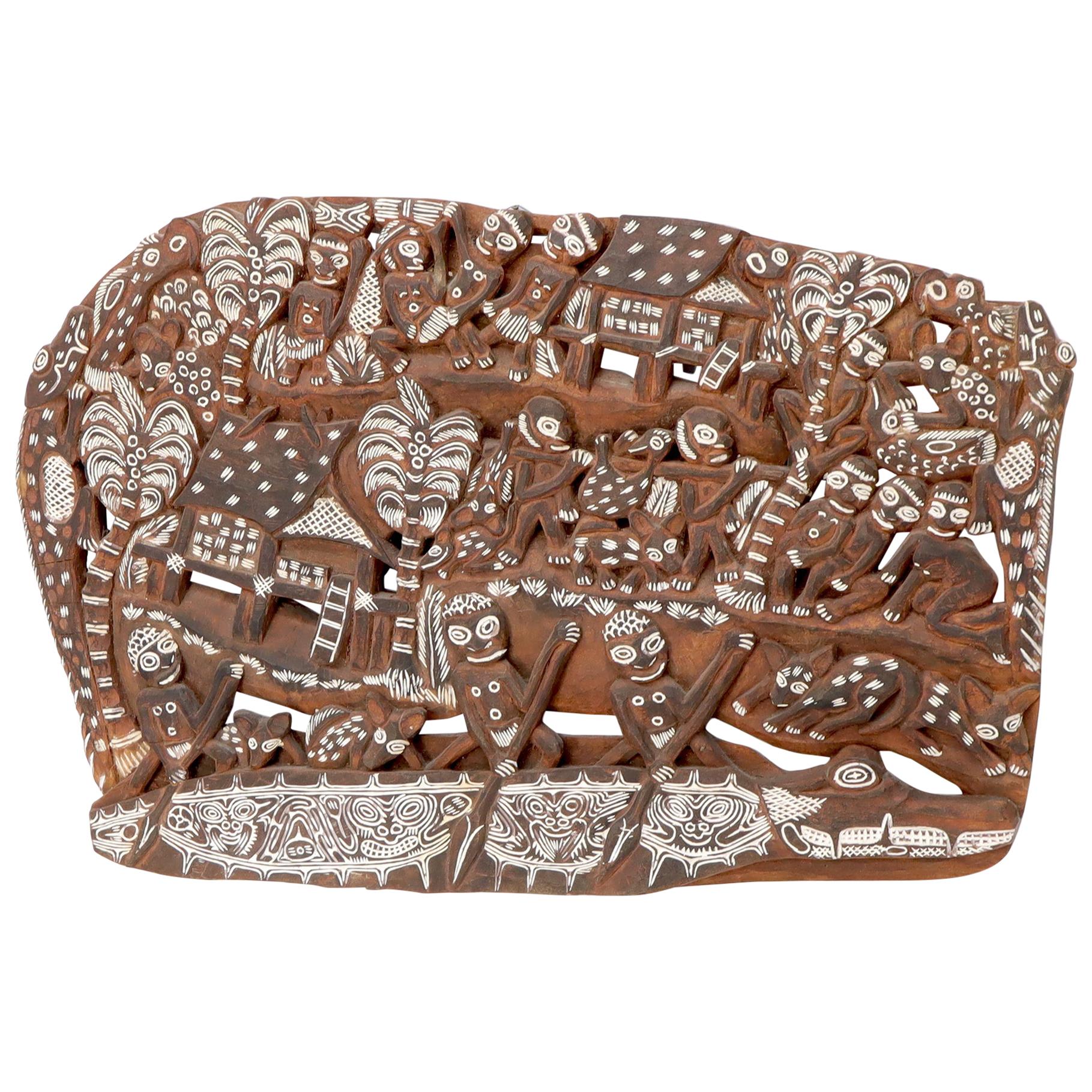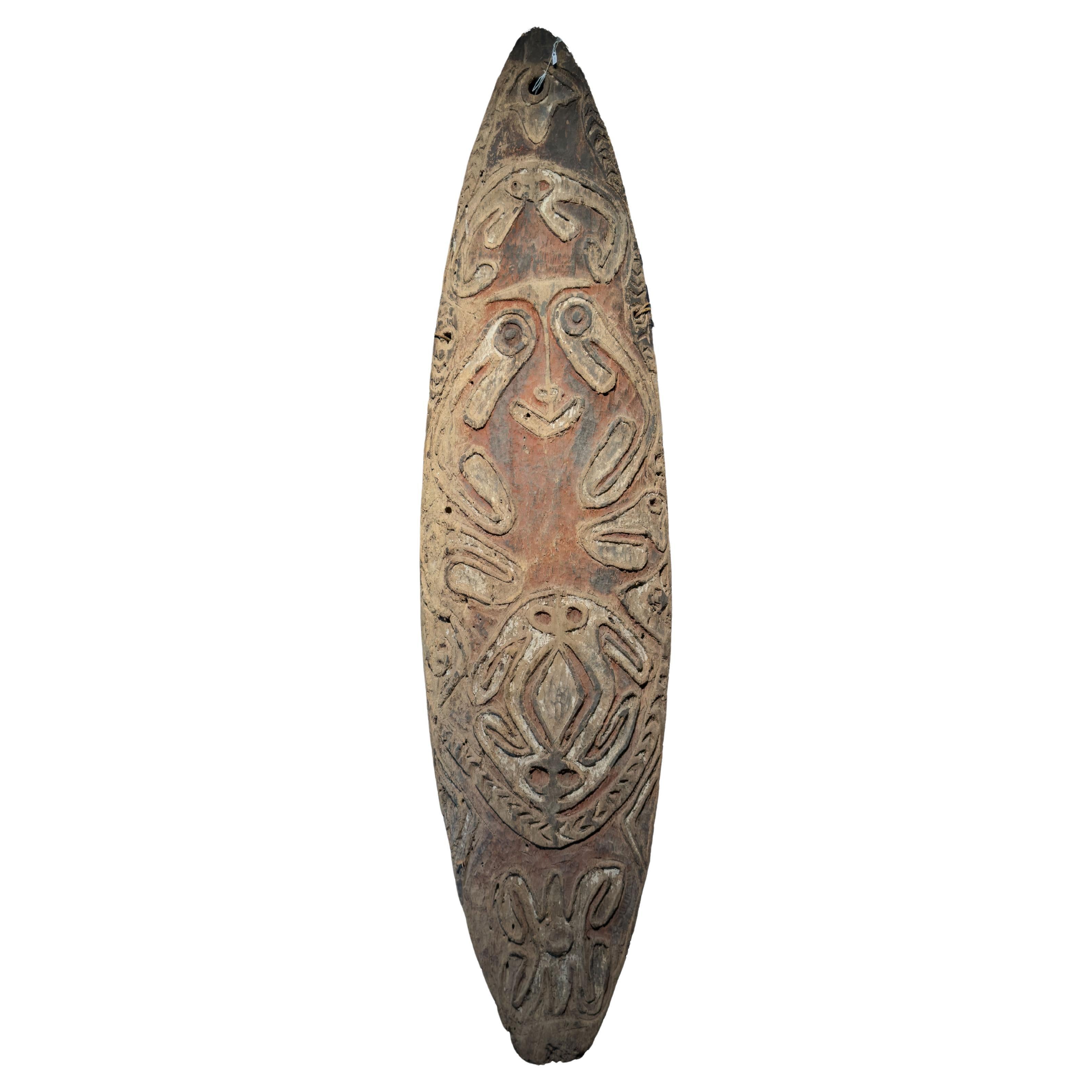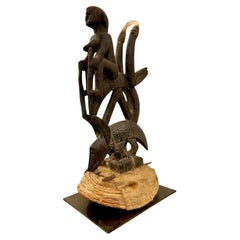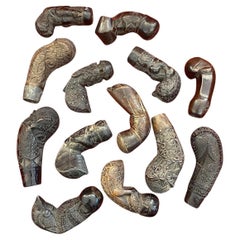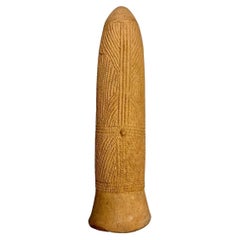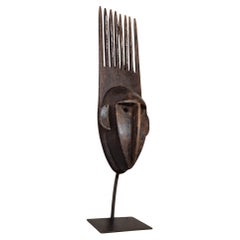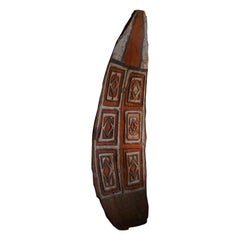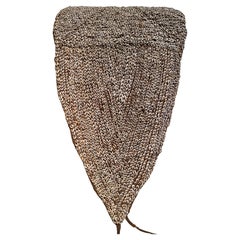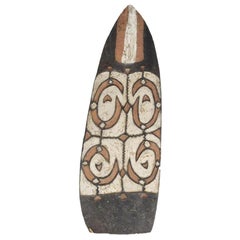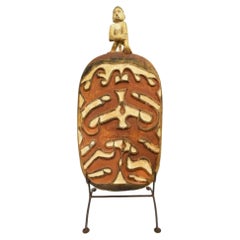Items Similar to Shell Plaque (Barava) from Solomon Islands, 19th Century
Want more images or videos?
Request additional images or videos from the seller
1 of 6
Shell Plaque (Barava) from Solomon Islands, 19th Century
$8,326.52
£6,155.91
€6,980
CA$11,453
A$12,730.73
CHF 6,673.17
MX$155,472.96
NOK 83,310.72
SEK 78,379.85
DKK 53,138.62
About the Item
Objects crafted from the shell of the giant Tridacna clam, also known as the fossilized giant clam, held great value among numerous Melanesian peoples. The artistry of working with fossilised Tridacna reached its zenith in the Solomon Islands, particularly evident in the creation of intricate and prestigious objects like the barava – perforated plates originating from the western Solomon Islands.
While some barava designs feature geometric patterns, many incorporate stylised human figures intertwined with shapes reminiscent of faces, characterised by spiral eyes and smiling mouths adorned with tiny teeth. Traditionally, barava were closely linked with burial sites, often used to embellish structures housing the skulls of esteemed individuals or enemies, or placed atop graves. In the past, certain barava even played a role in vovoso, potent charms worn aboard war canoes during headhunting expeditions, safeguarding the crew and ensuring successful endeavours.
The Didier Zanette Collection offers insight into these remarkable artefacts. Additionally, a selection of other 19th-century objects crafted from giant clam shells remains available.
For further exploration of this fascinating subject, refer to the book:
"Tridacna Gigas: Objects of Prestige in Melanesia"
by Éric Lancrenon and Didier Zanette
ISBN: 9782915654929
Publisher: Au vent des îles
Publication Date: November 16, 2011
Series: Pacific Culture
Pages: 277
Dimensions: 29.5 x 23.5 x 2.9 cm
- Dimensions:Height: 4.34 in (11 cm)Width: 8.27 in (21 cm)Depth: 1.19 in (3 cm)
- Style:Tribal (In the Style Of)
- Materials and Techniques:
- Place of Origin:
- Period:
- Date of Manufacture:19th Century
- Condition:Wear consistent with age and use.
- Seller Location:NICE, FR
- Reference Number:1stDibs: LU9202238961072
About the Seller
5.0
Gold Seller
Premium sellers maintaining a 4.3+ rating and 24-hour response times
Established in 2003
1stDibs seller since 2023
32 sales on 1stDibs
Typical response time: 2 hours
- ShippingRetrieving quote...Shipping from: NICE, France
- Return Policy
Authenticity Guarantee
In the unlikely event there’s an issue with an item’s authenticity, contact us within 1 year for a full refund. DetailsMoney-Back Guarantee
If your item is not as described, is damaged in transit, or does not arrive, contact us within 7 days for a full refund. Details24-Hour Cancellation
You have a 24-hour grace period in which to reconsider your purchase, with no questions asked.Vetted Professional Sellers
Our world-class sellers must adhere to strict standards for service and quality, maintaining the integrity of our listings.Price-Match Guarantee
If you find that a seller listed the same item for a lower price elsewhere, we’ll match it.Trusted Global Delivery
Our best-in-class carrier network provides specialized shipping options worldwide, including custom delivery.More From This Seller
View AllCiwara Bambara headdress in carved wood and basketry, Mali, Early 20th century
Located in NICE, FR
A very pleasing Ciwara crest, singularly small and accompanied by its original headdress, depicting a stylized antelope leaning on a pangolin. The antelope is ridden by a woman, and white horsehair has been added to the tips of the horns. The piece is carefully sculpted, with notches decorating the bodies of the antelope and the pangolin.
Rattan, plant fiber, cowries, wood Very fine velvety mat patina, Circa 1950
An animal called Ciwara is said to have taught the Bambara how to cultivate the land, and during agrarian ceremonies, they recall the myth through the stylized representation of an antelope whose name ci wara...
Category
Early 20th Century Malian Tribal Tribal Art
Materials
Wood
Collection of Kriss Handles, Java, Indonesia, Late 18th / Early 19th Century
Located in NICE, FR
A set of thirteen kriss handles originating from Java, Indonesia, dating from the late 18th to early 19th century.
Beautiful aged patina in dark or amber tones. Exquisite carving wo...
Category
Antique 1790s Indonesian Tribal Tribal Art
Materials
Wood
16th Century Ceremonial Urn from Burkina Faso, Africa
Located in NICE, FR
Beautiful funerary terracotta urn called from the Bura region (Niger) in West Africa. This cylindrical anthropomorphic sculpture is adorned with geometric designs. It depicts a human...
Category
Antique 16th Century Burkinabe Tribal Urns
Materials
Terracotta
Bamana N'tomo mask, Mali, 20th century
Located in NICE, FR
Bamana N'tomo mask, Mali, 20th century
"Generally surmounted by three to eight horns forming a comb, the N'tomoface mask refers to a moment of compulsory education given to uncircumcised young boys in certain West African societies. The mask's discreet, even absent, mouth emphasizes the behavior expected of them in their future adult life after training: controlling and measuring their words, knowing how to keep quiet, preserving secrets and enduring pain in silence."
Excerpt from Masques du N'tomo, Marc Ladreit de Lacharrière Collection, Musée du Quai Branly Jacques Chirac, France.
The Bambara, or Bamana, live in central and southern Mali. Their name means “unbeliever” and was given to them by the Muslims. Animists, they believe in the existence of a creator god called Ngala, who maintains the order of the universe and coexists with another androgynous god called Faro, master of the Word, who gave all qualities to mankind and makes the fruits of the earth grow. Traditional Bamana art objects are closely linked to agrarian rites.
The Bamana dance these masks during initiation and circumcision ceremonies for young boys in the Ntomo society. The face, with its vertical outgrowths at the top, adopts geometric features beneath a rounded forehead, including an imposing busted nose, as the Bamana favor this organ in their statuary as it evokes sociability and clan cohesion. Indeed, during choreography, the dancer frequently touches the nose of the mask.
As teaching aids for candidates, masks from societies accessible to young boys and adults, such as the N'tomo, Korè and Ci wara...
Category
Vintage 1930s Malian Tribal Tribal Art
Materials
Wood
Ndoma Baule Portrait Mask, Ivory Coast, Wood, lacquered patina, Circa 1930
Located in NICE, FR
"Ndoma” Baule Portrait Mask, Ivory Coast, Circa 1930 Wood, heavy wood with deep brown-black lacquered patina.
A superb old hardwood dance mask featuring an ...
Category
Vintage 1930s Tribal Tribal Art
Materials
Wood
Rare Kanak "kagu" Wooden Bird Beak Puzzle, New Caledonia, 19th Century
Located in NICE, FR
Rare Kanak war club of the "Kagu" type (Bird's beak) in hardwood, from New Caledonia, Melanesia, 19th century.
This is an exceptional Kanak art collector's item due to its imposing ...
Category
Antique Mid-19th Century New Caledonian Tribal Art
Materials
Wood
You May Also Like
Oceanic Vintage Shield, Tribal Wall Art, Papua New Guinea, Late 19th Century
Located in Odense, DK
A large decorative and rare hand carved tribal war shield in traditional colors, made in Papua New Guinea in the late 19th century. Functional as beautiful ...
Category
Antique Late 19th Century Papua New Guinean Primitive Decorative Art
Materials
Wood, Paint
$1,800 Sale Price
20% Off
Shell Ceremonial Object from Papua New Guinea
Located in Schellebelle, BE
A remarkable Ceremonial Object from Papua New Guinea,
made of small shells mounted on fabric,
very decorative item, used for ceremonies,
good patina and shine of the object, nice obj...
Category
Vintage 1970s Asian Tribal Art
Materials
Shell, Fabric
Monumental Oceanic Asmat People Carved Painted Wooden War Shield
Located in Forney, TX
A monumental, rare and important Oceanic Papuan Asmat People tribal carved war shield from the first half of the 20th century, collected from the coast of the headhunting tribe in Papua New Guinea, a Provincial Indonesian island in the mid 20th century.
Among the Asmat, war shields are the most powerful symbolic element of a warrior's equipment, and have many layers of meaning. Traditionally, they were functional items used to protect warriors in battle by deflecting an enemy's spears and arrows. The carved and painted images on the surface of the shields were also intended to frighten the enemy and symbolize the power of the ancestors.
Ancestral imagery appears on multiple forms of Asmat art...
Category
Early 20th Century Papua New Guinean Tribal Tribal Art
Materials
Wood
Important Oceanic Carved Asmat Tribal Sago Bowl Serving Platter after War Shield
Located in Forney, TX
A rare and important Oceanic Papuan Asmat tribal carved ancestral sago bowl (also known as a platter, serving shield and tray) crafted in the likes of the...
Category
20th Century Papua New Guinean Tribal Tribal Art
Materials
Wood, Paint
Large Carved Teak Decorative Tribal Wall Art Plaque Sculpture Native People
Located in Rockaway, NJ
Heavily carved large African tribal art wall plaque sculpture.
Category
20th Century African Wall-mounted Sculptures
Materials
Hardwood
A rare Papua 'Gope' Spirit board from the Schulze Westrum collection
Located in Amsterdam, NL
A rare Papua 'Gope' Spirit board from the Schulze Westrum collection
New Guinea, Papua Gulf, probably Urama people, late 19th–early 20th century
Attached to the back are several 'b...
Category
Antique Late 19th Century Papua New Guinean Tribal Art
Materials
Wood
